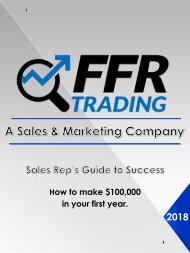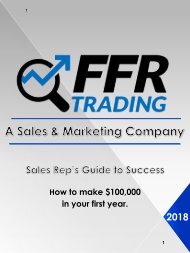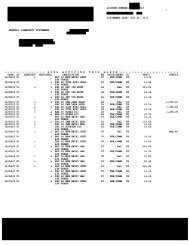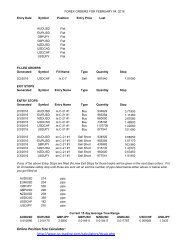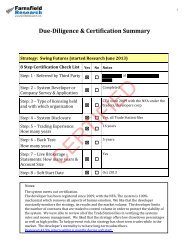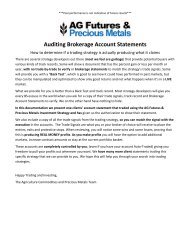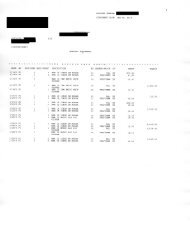The 3Dimensional Trading Breakthrough
Create successful ePaper yourself
Turn your PDF publications into a flip-book with our unique Google optimized e-Paper software.
<strong>The</strong> 3 Dimensional <strong>Trading</strong> <strong>Breakthrough</strong><br />
<strong>The</strong> futures contracts are one-dimensional instruments in and of themselves. That<br />
is, you can either be “long” or “short” the market on a one-to-one basis and be<br />
either correct or incorrect in your speculation. For centuries, this has been the<br />
challenge of speculators, hedgers, and users alike. Our challenge for this book is<br />
to minimize this risk while maximizing gains. More to come...<br />
<strong>The</strong> Stock<br />
<strong>The</strong> stock holdings that we have grown up with have been the most popular<br />
investment instrument since its introduction over two centuries ago. You don’t<br />
need me, or anyone else, to tell you that you must “buy low, sell high” to make<br />
money with stocks. Stocks are generally a small ownership in an individual<br />
company.<br />
Unlike futures contracts – which can be “sold short” as easily as “bought long,”<br />
– most folks only understand they can buy stocks as an investment with the intent<br />
to make money over the longer term. However, they are also assuming the risks<br />
associated with the business management and ownership. It is not a common<br />
practice “shorting” stocks (as we practice it in the futures markets) – as the ability<br />
to borrow shares for shorting varies from stock to stock, and from day to day.<br />
Since we are comparing futures contracts with stock ownership, let me add that<br />
higher margin is required from the stock trader for similar gains to those in the<br />
futures markets. This is why many traders are converting their time and effort<br />
(and risk funds!) into trading the commodity futures markets. Also, since the<br />
underlying asset of the stock is the company itself, no one knows better the<br />
financial soundness, future plans, business outlook, etc. than those who directly<br />
run the company. Although “insider trading,” which we are alluding to, is a highly<br />
illegal practice and carefully scrutinized by the federal government, it still takes<br />
place (and always will in one form or another.) If you contrast this with commodity<br />
markets, you will know that it is darn near impossible, and highly unlikely, that any<br />
one individual or small group of people can direct the market in their favor - there<br />
is simply too much corn, cattle, sugar, petroleum, etc. in the world for any one<br />
person, entity, or small group to control (although it has been tried!).<br />
It has only been the past decade that stock traders could take advantage of electronic<br />
trading through the use of the modern day Internet. This gave brokerage firms the<br />
ability to get traders in/out of the market at a very deep discount rate. Granted,<br />
the risk of error is “transferred” from the broker (representing the brokerage firm)<br />
- 30 -





